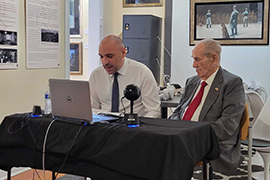- Slug: BC-CNS-Anne Frank VR,700.
- Photo, video story available (thumbnail, caption below)
By Shira Tanzer
Cronkite News
PHOENIX – The Arizona Jewish Historical Society is opening a new interactive activity as part of its exhibit “Stories of Survival: An Immersive Journey Through the Holocaust.”
It utilizes virtual reality to guide visitors through the Netherlands home of Anne Frank, the young girl whose life is memorialized in the diary she kept from age 13 until she was killed by the Nazis at age 16. By seeing the home and secret annex where Frank’s family hid from the Nazis for more than two years, guests and students are able to get an up close and personal view of what it was like to live in hiding during the Holocaust.
As part of the exhibit preview, the Jewish Historical Society hosted a talk in February with guest speaker Andrew Schot, a Holocaust survivor who now lives in Tucson.
Schot lived across the street from the Frank family before World War II broke out, even walking to school with Anne and her sister, Margot. When the Germans invaded the Netherlands in 1940 and the Franks went into hiding, Schot remembered seeing Miep Gies, the friend who essentially kept the Franks alive while they were in hiding, walking to and from the house. Schot said bringing the history of the Holocaust into today’s era through technology will give people, especially students just learning about the Holocaust, a better understanding of the events.
“The use of technology makes it so much easier. It would take three or four hours to lecture about what they do here in minutes,” Schot said.
Through the use of new methods of teaching, educators are finding it easier to connect to a generation of students that have grown up with the internet. The new virtual reality exhibit places them into another time and gives them a virtual firsthand experience of the events they are viewing.
Anne Frank is used as an example in classrooms across the world to educate young students about the Holocaust and what Jewish people went through during World War II. Frank has been a symbol for a younger generation to learn about the Holocaust as research shows significant gaps in knowledge about the Holocaust and the nearly 6 million Jewish people killed. Frank’s diary is written from her point of view, and the Jewish Historical Society’s exhibit allows visitors to catch a glimpse of the war through her eyes.
“When I stand in front of a bunch of kids, eighth or ninth graders, and I tell them I went to school with Anne Frank, I’ve got their attention,” Schot said. “It’s the experience of someone their own age, not some old person.”
Holocaust education in Arizona has been gaining more attention over the past few years, with an Arizona law signed by then-Gov. Doug Ducey in 2021 that requires public schools to teach students about the Holocaust and other genocides at least twice between seventh and 12th grades.
Lawrence Bell, executive director of the Arizona Jewish Historical Society, said history has a way of repeating itself, and the only way to prevent future genocide is to teach the next generation about the Holocaust and how it happened so they can make sure it never happens again.
“A big part of why we’re doing this is to educate young people, especially who probably don’t have a lot of prior knowledge about the Second World War or the Holocaust – to take this new generation of people and make them aware of what happened,” Bell said, noting multiple schools come through the museum each week.
The museum’s “Stories of Survival” exhibit features testimonies from four Arizona Holocaust survivors through media such as an interactive hologram – and, as of this week,virtual reality. The exhibit runs through the end of the year.
There has been one other virtual reality tour offered through the Jewish Historical Society in the past, which featured a concentration camp, but the Anne Frank house tour is the first interactive virtual exhibit, where visitors can open doors and choose where in the house to go.
The virtual reality exhibit opens to the public Monday, and is a free experience included with the museum’s $5 admission fee. Students, military and museum members get in free.
For more stories from Cronkite News, visit cronkitenews.azpbs.org.
^__=
Holocaust survivor Andrew Schot, right, speaks at the Arizona Jewish Historical Society on Feb. 24, 2023, with Anthony Fusco Jr., who is the society’s education coordinator. (Photo by Shira Tanzer/Cronkite News)
